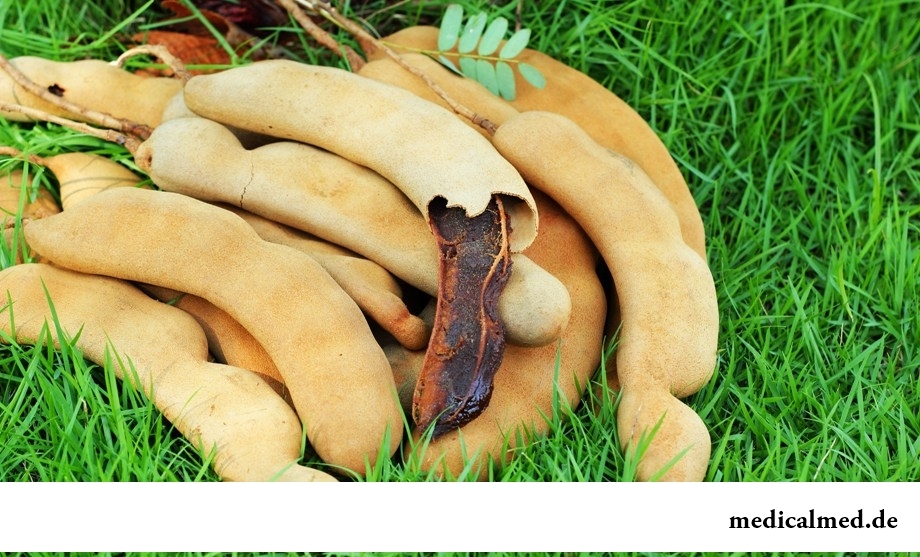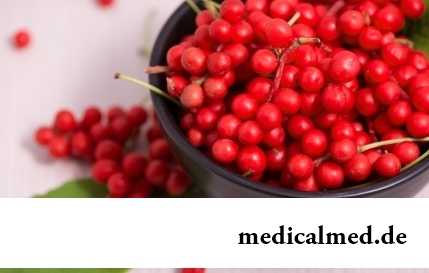





Tamarind
The tamarind is a plant from family bean and sorts the Indian dates. Fruits of a tamarind grow on a tropical tree.

Biological features and distribution
For the first time the tamarind was grown up in the territory of East Africa, and then extended across all Africa in rainforests and was delivered to Asia. In the 16th century the plant began to be grown up in South and Central America. In height the tree reaches 20 meters, is evergreen and has dark red wood. Tamarind leaves difficult, flowers have small inflorescences, and fruits represent silicular beans with a set of seeds.
This fruit is widespread and popular in South America as ingredient for various dishes. Fruits of a tamarind have brown color, sweetish taste with characteristic smack, juicy pulp and firm change. Process of maturing of fruits lasts from the middle of spring prior to the beginning of summer.
Wild-growing species of a tamarind are widespread on Caribbean Islands, in the countries of East Asia and Sudan. In the tropical countries of Africa and Asia the tree is cultivated.
The tamarind is a hygrophilous plant which demands regular watering and a drainage of the soil. Reproduction of a plant happens in the seed way, germination lasts for 10 days, and the first inflorescences appear after 6-7 years.
Useful properties of a tamarind and its use
Useful properties of a tamarind are caused by its structure, vitamin-rich and microelements. Do medical tea which is effective for treatment of diseases of respiratory system, fever and diarrhea of this fruit. Broth of fruits of fruit possesses antiinflammatory and laxative actions.
At regular consumption of a tamarind appetite improves and arterial pressure is normalized. Thanks to high useful properties of a tamarind, it is used at diseases of the alimentary system, disorders of intestines and problems with digestion of food.
Vitamins A and With, organic acids which have the protivogelmintny, knitting and antiedematous properties are a part of a tamarind.
Fruit pulp juicy and edible, it is used as ingredient for vegetable dishes, desserts and sauces, and also it is applied as spice in Asian and American cuisines. Pulp of unripe fruits is used for preparation of hot dishes and drinks, and the ripened fruits add to salads and snack.
Wood of a tamarind is used for production of furniture, home decoration and floor coverings.
In the medical purposes pulp, bark and leaves of a plant is applied. From leaves prepare herbal tea, broths and infusions.
India does liquid dishes, rice baked puddings and various drinks of fruit. In the countries to South America the tamarind is popular ingredient for various sweets, and also it is eaten in the dried, salty and candied look.
In Europe this fruit began to be used as additional ingredient for second courses and desserts (mousse, jelly, fruit salad, smuz, etc.).
Mousse from a tamarind possesses fortifying and tonic action. He is trained from pulp of beans, filled in with boiled water and cook to a dense consistence. Then add sugar to broth and shake up to mousse. Such dish normalizes digestion, strengthens walls of vessels and improves work of cardiovascular system.

Tamarind contraindications
Contraindications to the use of a tamarind are the individual intolerance and predisposition to allergic reactions to this fruit.
The tamarind should not be eaten at a serious illness of the alimentary system, disorders of intestines, hormonal disturbances and serious inflammatory processes in internals.
This fruit cannot be used in a large number as it can cause a digestive disturbance and diarrhea.
Drug for cough Terpinkod is one of leaders of sales, not because of the medicinal properties at all.

Health and attractiveness - eternal values, pursuing which people often use the most unusual ingredients and technicians...
Section: Articles about health
Reactive pancreatitis - the disease which is characterized by inflammatory process in a pancreas which arises most often because of excess activity of digestive enzymes. It − the emergency state which treatment has to take place in хирургич...
Section: Articles about health
The climax, or menopause is the normal process of the termination of genital function of the woman which is followed by serious hormonal changes in an organism. Usually the menopause begins at the age of 50-55 years, but characteristics of this process are very individual. Factors of earlier approach of a climax are irregular sex life, numerous abortions, addictions, existence of endocrine, autoimmune and gynecologic diseases, frequent stresses and excessive hobby of diets...
Section: Articles about health
Neurosis is called pathology of a nervous system at which deviations in functioning of the highest nervous processes are observed. Nye...
Section: Articles about health
Women quite often suffer from complexes concerning the sizes of the bust. Strangely enough, not too modest, and excessively curvy shapes become the reason of sincere discomfort sometimes. Except psychological problems, a big bust sometimes with...
Section: Articles about health
According to World Health Organization, every third inhabitant of Earth has excess weight, and every tenth has obesity. The reason of this phenomenon, according to specialists, roots in one not very comforting fact: most of people consume much more calories, than it is necessary. How it turns out what we overeat? Why it is so difficult to refuse an excess portion tasty or additives? Let's try to find out what factors prevent us to eat food with reasonable moderation....
Section: Articles about health
Herpes simplex of the first type (the infectious disease which is shown periodic bubble rashes on is called...
Section: Articles about health
Condition of lips (their morbidity, outward) – one of indicators of health of the person. The peeling, dryness, pallor, and also cracks in corners of a mouth can be not only the cosmetic shortcoming which arose owing to physical damages and weather having sent away...
Section: Articles about health
Many of us, probably, noticed more than once that from intellectual loadings at some point the brain as though "overheats" and "assimilation" of information is strongly slowed down. Especially this problem urgent for persons of age becomes more senior than fifty years. "Already badly I think", "the head will burst now", "memory as if is disconnected" - here that wants to be told at the time of information overload....
Section: Articles about health
The state of health of the person depends on many factors. One of the most important is the constant but which is not exhausting, motive...
Section: Articles about health
Today about 30 diseases, sexually transmitted are known. Wide circulation of these illnesses is extremely promoted by the dual attitude towards them: on the one hand, most of people know about "shameful" diseases and not a stirrup very little...
Section: Articles about health
Life of the modern woman is very difficult. Opportunities to realize itself are wide: it not only education and career, but also the most various hobbies from sport before needlework. It is not less important to build private life, paying an attention maximum to children, the husband, parents, friends. For all these affairs there is catastrophically not enough time therefore each of us tries to cut down as far as possible its expenses on necessary, but not the most fascinating housework. With it we are successfully helped by means...
Section: Articles about health
Statistically, pathologies of a thyroid gland in the world more than 500 million people have. Failures in work of this body conduct to is heavy...
Section: Articles about health
Eyes – one of the most vulnerable areas on a face therefore age changes concern them first of all. Whether it is possible to keep look youth for many years and what procedures are offered for achievement of this purpose by cosmetologists? And maybe, only thing of a vari...
Section: Articles about health
New year, wedding, birthday, office party – an occasion to drink at the Russian person will always be. How to reduce a negative impact of alcohol by an organism and to avoid a condition of strong intoxication? The most correct council – to refuse the use of alcoholic drinks. Council is true, but not always feasible. We offer several advice which will help you in cases when it is impossible to avoid alcohol intake....
Section: Articles about health
Statistically cystitis 25-30% of women up to 40 years have. With age this indicator raises, besides many do not get in to become...
Section: Articles about health
The saying "the rich do not know how the other half lives" is known to all. In a broad sense it is that we can not always understand the person whose features of a state are unknown to us. If with physiological characters of diseases the situation is more or less clearly (having noticed and...
Section: Articles about health
High temperature - a frequent symptom of such widespread diseases as a SARS, quinsy, pneumonia, etc. To reduce heat, having facilitated a condition of the patient, doctors recommend to accept antipyretics, however their use is not always possible. Too frequent use of these drugs can lead to allergic reactions, and also overdose, causing poisoning. It happens also that there are no antipyretics simply in the house. In these situations it is pertinent to use it...
Section: Articles about health
Turnip, radish, horse-radish – once these and other products enjoyed wide popularity at our ancestors, being not only food, N...
Section: Articles about health
Tea is loved and use almost everything. This drink has tonic properties, contains the tannins capable to suppress activity of causative organisms. Recently great popularity was gained by teas with vegetable additives. Лечеб...
Section: Articles about health
The thought that the mass of their body is too big at least once in life visits from 80 to 95% of women. Many women are so obsessed with this idea that constantly try all new and new ways of weight reduction. A considerable part of these techniques is ineffective, and some in general are unsafe for health....
Section: Articles about health
Not without reason doctors say that 90% of diseases begin or develop because of misoperation of intestines. Disturbance of its functions связ...
Section: Articles about health
One of the major chemical processes happening in a human body are oxidation reactions. They go with participation of fats and carbohydrates which we receive from food, and the oxygen getting to us from air. A main goal of such reactions is it is received...
Section: Articles about health
Phobia – the persuasive fear of a certain contents shown in a specific situation against the will of the person. Concepts of a phobia and fear are similar, however if the fear is natural protective function of mentality, then the phobia is its deviation. So the person can feel the unaccountable, baseless fear accompanied with neurotic symptoms (perspiration, a shiver, a fever) before any ordinary phenomenon – for example, a trip by the subway or a simple dog....
Section: Articles about health
Separate food - the system of meal based on digestion physiology which is carried to improvement methods. In opinion д...
Section: Articles about health
Sometimes it seems that modern society was divided into two camps: representatives of the first are sure that only the woman has to be responsible for contraception, representatives of the second, respectively, are sure that it is destiny of men. Meanwhile Dov has a question of contraception...
Section: Articles about health
Dietary supplements (dietary supplements) for the last decades were so thoroughly included into our life that, apparently, it is already impossible to find the person who at least once did not try them. At the same time, most of our compatriots have a vague idea of what dietary supplements as they affect a human body consist of and what differ from the real medicines in. Let's try to understand these questions, and at the same time and to understand, such additives are how necessary for us....
Section: Articles about health
